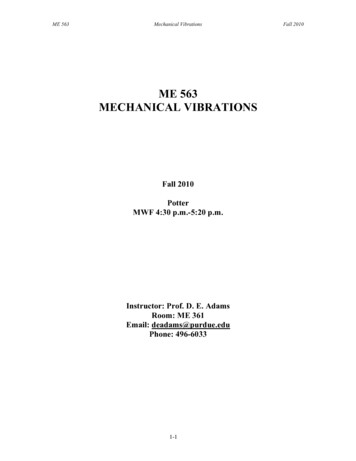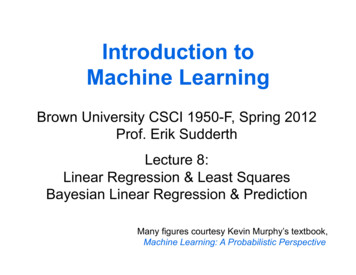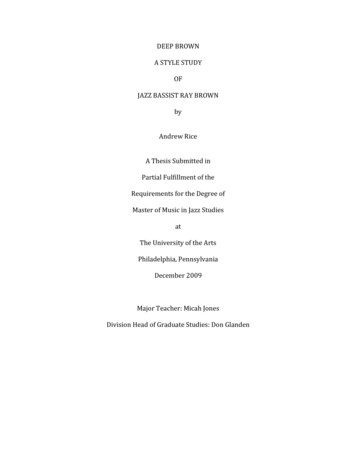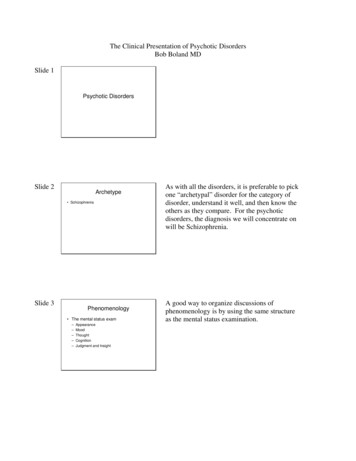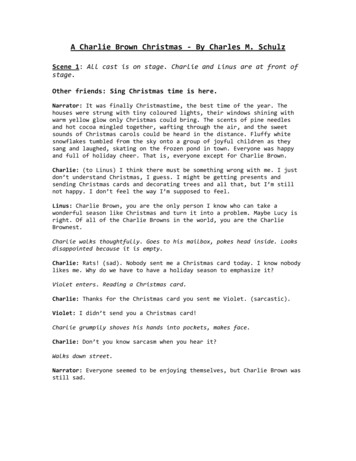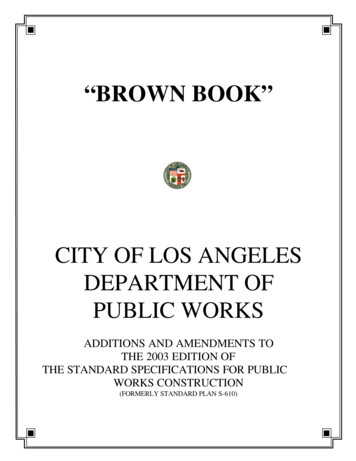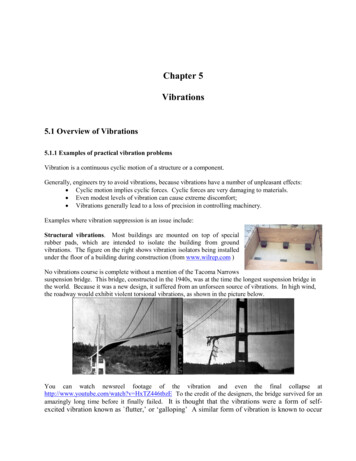
Transcription
Chapter 5Vibrations5.1 Overview of Vibrations5.1.1 Examples of practical vibration problemsVibration is a continuous cyclic motion of a structure or a component.Generally, engineers try to avoid vibrations, because vibrations have a number of unpleasant effects: Cyclic motion implies cyclic forces. Cyclic forces are very damaging to materials. Even modest levels of vibration can cause extreme discomfort; Vibrations generally lead to a loss of precision in controlling machinery.Examples where vibration suppression is an issue include:Structural vibrations. Most buildings are mounted on top of specialrubber pads, which are intended to isolate the building from groundvibrations. The figure on the right shows vibration isolators being installedunder the floor of a building during construction (from www.wilrep.com )No vibrations course is complete without a mention of the Tacoma Narrowssuspension bridge. This bridge, constructed in the 1940s, was at the time the longest suspension bridge inthe world. Because it was a new design, it suffered from an unforseen source of vibrations. In high wind,the roadway would exhibit violent torsional vibrations, as shown in the picture below.You can watch newsreel footage of the vibration and even the final collapse athttp://www.youtube.com/watch?v HxTZ446tbzE To the credit of the designers, the bridge survived for anamazingly long time before it finally failed. It is thought that the vibrations were a form of self-excited vibration known as flutter,’ or ‘galloping’ A similar form of vibration is known to occur
2in aircraft wings. Interestingly, modern cable stayed bridges that also suffer from a new vibration problem:the cables are very lightly damped and can vibrate badly in high winds (this is a resonance problem, notflutter). You can find a detailed article on the subject at www.fhwa.dot.gov/bridge/pubs/05083/chap3.cfm.Some bridge designs go as far as to incorporate active vibration suppression systems in their cables.Vehicle suspension systems are familiar to everyone, but continue to evolve asengineers work to improve vehicle handling and ride (the figure above is fromhttp://www.altairhyperworks.com. A radical new approach to suspension designemerged in 2003 when a research group led by Malcolm Smith at CambridgeUniversity invented a new mechanical suspension element they called an ‘inerter’.This device can be thought of as a sort of generalized spring, but instead of exerting aforce proportional to the relative displacement of its two ends, the inerter exerts aforce that is proportional to the relative acceleration of its two ends. An actualrealization is shown in the figure. You can find a detailed presentation on the theorybehind the device at http://www-control.eng.cam.ac.uk/ mcs/lecture j.pdf Thedevice was adopted in secret by the McLaren Formula 1 racing team in 2005 (theycalled it the ‘J damper’, and a scandal erupted in Formula 1 racing when the Renaultteam managed to steal drawings for the device, but were unable to work out what itdoes. The patent for the device has now been licensed Penske and looks to becomea standard element in formula 1 racing. It is only a matter of time before it appearson vehicles available to the rest of us.Precision Machinery: The picture on the right shows one example of a precisioninstrument. It is essential to isolate electron microscopes from vibrations. A typicaltransmission electron microscope is designed to resolve features of materials down toatomic length scales. If the specimen vibrates by more than a few atomic spacings, itwill be impossible to see! This is one reason that electron microscopes are alwayslocated in the basement – the basement of a building vibrates much less than the upperfloors. Professor K.-S. Kim at Brown recently invented and patented a new vibrationisolation system to support his atomic force microscope on the 7th floor of the BarusHolley building – you can find the patent at United States Patent, Patent Number 7,543,791.Here is another precision instrument that is very sensitive to vibrations.
3The picture shows features of a typical hard disk drive.It is particularly important to prevent vibrations in thedisk stack assembly and in the disk head positioner,since any relative motion between these twocomponents will make it impossible to read data. Thespinning disk stack assembly has some very interestingvibration characteristics (which fortunately for you, isbeyond the scope of this course).Vibrations are not always undesirable, however. On occasion, theycan be put to good use. Examples of beneficial applications ofvibrations include ultrasonic probes, both for medical application andfor nondestructive testing. The picture shows a medical applicationof ultrasound: it is an image of someone’s colon. This type ofinstrument can resolve features down to a fraction of a millimeter,and is infinitely preferable to exploratory surgery. Ultrasound is alsoused to detect cracks in aircraft and structures.Musical instruments and loudspeakers are a second example ofsystems which put vibrations to good use. Finally, most mechanical clocks use vibrations tomeasure time.5.1.2 Vibration MeasurementWhen faced with a vibration problem, engineers generally start by making somemeasurements to try to isolate the cause of the problem. There are two commonways to measure vibrations:1. An accelerometer is a small electro-mechanical device that gives an electricalsignal proportional to its acceleration. The picture shows a typical 3 axisMEMS accelerometer (you’ll use one in a project in this course). MEMS accelerometers should beselected very carefully – you can buy cheap accelerometers for less than 50, but these are usuallymeant just as sensors, not for making precision measurements. For measurements you’ll need toselect one that is specially designed for the frequency range you are interested in sensing. The bestaccelerometers are expensive ‘inertial grade’ versions (suitable for so-called ‘inertial navigtation’ inwhich accelerations are integrated to determine position) which are often use Kalman filtering tofuse the accelerations with GPS measurements.2. A displacement transducer is similar to an accelerometer, but gives an electrical signal proportionalto its displacement.Displacement transducers are generally preferable if you need to measure low frequency vibrations;accelerometers behave better at high frequencies.
45.1.3 Features of a Typical Vibration ResponseDisplacement orAccelerationThe picture below shows a typical signal that you mightrecord using an accelerometer or displacementtransducer.Period TPeak to peakamplitudeImportant features of the response areThe signal is often (although not always) periodic: thatis to say, it repeats itself at fixed intervals of time.Vibrations that do not repeat themselves in this wayare said to be random. All the systems we consider inthis course will exhibit periodic vibrations.TimeThe PERIOD of the signal, T, is the time required forone complete cycle of oscillation, as shown in the picture.The FREQUENCY of the signal, f, is the number of cycles of oscillation per second. Cycles persecond is often given the name Hertz: thus, a signal which repeats 100 times per second is said tooscillate at 100 Hertz.The ANGULAR FREQUENCY of the signal, ω , is defined as ω 2π f . We specify angularfrequency in radians per second. Thus, a signal that oscillates at 100 Hz has angular frequency200π radians per second.Period, frequency and angular frequency are related by1f T2πω 2π f TThe PEAK-TO-PEAK AMPLITUDE of the signal, A, is the difference between its maximumvalue and its minimum value, as shown in the pictureThe AMPLITUDE of the signal is generally taken to mean half its peak to peak amplitude.Engineers sometimes use amplitude as an abbreviation for peak to peak amplitude, however, so becareful.The ROOT MEAN SQUARE AMPLITUDE or RMS amplitude is defined as1/2 1 T 2 σ [ y (t )] dt T 0
55.1.4 Harmonic OscillationsHarmonic oscillations are a particularly simple form of vibration response. A conservative spring-masssystem will exhibit harmonic motion – if you have Java, Internet Explorer (or a browser plugin that allowsyou to run IE in another browser) you can run a Java Applet to visualize the motion. You can findinstructions for installing Java, the IE plugins, and giving permission for the Applet to run here. Theaddress for the SHM simulator (cut and paste this into the Internet Explorer address ourses/En4/java/shm.htmlIf the spring is perturbed from its static equilibrium position, it vibrates (press start’ to watch the vibration).We will analyze the motion of the spring mass system soon. We will find that the displacement of the massfrom its static equilibrium position, x , has the formx(t ) X sin(ω t φ )Here, X is the amplitude of the displacement, ω is the frequency of oscillations in radians per second,and φ (in radians) is known as the phase’ of the vibration. Vibrations of this form are said to beHarmonic.Typical values for amplitude and frequency are listed in the table belowAtomic VibrationThreshold of human perceptionMachinery and building vibesSwaying of tall buildingsFrequency /HzAmplitude/mm101-810 710-10010 210 2 110-1000121-5We can also express the displacement in terms of its period of oscillation T 2π x(t ) t φ X sin T The velocity v and acceleration a of the mass follow as V sin (ω t φ )v(t ) V0 ω X cos (ω t φ )a (t ) A sin (ω t φ ) A ω V ω 2 XHere, V is the amplitude of the velocity, and A is the amplitude of the acceleration. Note the simplerelationships between acceleration, velocity and displacement amplitudes.Surprisingly, many complex engineering systems behave just like the spring mass system we are looking athere. To describe the behavior of the system, then, we need to know three things (in order of importance):(1) The frequency (or period) of the vibrations(2) The amplitude of the vibrations(3) Occasionally, we might be interested in the phase, but this is rare.So, our next problem is to find a way to calculate these three quantities for engineering systems.We will do this in stages. First, we will analyze a number of freely vibrating, conservative systems.Second, we will examine free vibrations in a dissipative system, to show the influence of energy losses in amechanical system. Finally, we will discuss the behavior of mechanical systems when they are subjected tooscillating forces.
65.2 Free vibration of conservative, single degree of freedom, linear systems.First, we will explain what is meant by the title of this section.Recall that a system is conservative if energy is conserved, i.e. potential energy kinetic energy constant during motion.Free vibration means that no time varying external forces act on the system.A system has one degree of freedom if its motion can be completely described by a single scalarvariable. We’ll discuss this in a bit more detail later.A system is said to be linear if its equation of motion is linear. We will see what this meansshortly.It turns out that all 1DOF, linear conservative systems behave in exactly the same way. By analyzing themotion of one representative system, we can learn about all others.We will follow standard procedure, and use a spring-mass system as our representative example.Problem: The figure shows a spring mass system. The spring hasstiffness k and unstretched length L0 . The mass is released with velocityv0 from position s0 at time t 0 . Find s (t ) .There is a standard approach to solving problems like this(i) Get a differential equation for s using F ma (or other methods to be discussed)(ii) Solve the differential equation.The picture shows a free body diagram for the mass.Newton’s law of motion states thatF ma Fs i ( N mg ) j m d 2sidt 2The spring force is related to the length of the spring by F s k ( s L0 ) . The i component of the equationof motion and this equation then shows thatmThis is our equation of motion for s.d 2sdt 2kL0 ks Now, we need to solve this equation. We could, of course, use Matlab to do this – in fact here is the Matlabsolution.syms m k L0 s0 v0 realsyms v(t) s(t)assume(k 0); assume(m 0);diffeq m*diff(s(t),t,2) k*s(t) k*L0;v(t) diff(s(t),t);IC [s(0) s0, v(0) v0];s(t) dsolve(diffeq,IC)
7In practice we usually don’t need to use matlab (and of course in exams you won’t have access to matlab!)5.2.1 Using tabulated solutions to solve equations of motion for vibration problemsNote that all vibrations problems have similar equations of motion. Consequently, we can justsolve the equation once, record the solution, and use it to solve any vibration problem we might beinterested in. The procedure to solve any vibration problem is:1. Derive the equation of motion, using Newton’s laws (or sometimes you can use energymethods, as discussed in Section 5.3)2. Do some algebra to arrange the equation of motion into a standard form3. Look up the solution to this standard form in a table of solutions to vibration problems.We have provided a table of standard solutions as a separate document that you can download andprint for future reference. Actually, this is exactly what MATLAB is doing when it solves adifferential equation for you – it is doing sophisticated pattern matching to look up the solution youwant in a massive internal database.We will illustrate the procedure using many examples.5.2.2 Solution to the equation of motion for an undamped spring-mass systemWe would like to solvemwith initial conditionsd 2sdt 2 ks kL0ds v0 from position s0 at time t 0 .dtWe therefore consult our list of solutions to differential equations, and observe that it gives thesolution to the following equation1 d 2xωn2 dt 2C x This is very similar to our equation, but not quite the same. To make them identical, divide ourequation through by kWe see that if we definem d 2s s
5.1.2 Vibration Measurement . When faced with a vibration problem, engineers generally start by making some measurements to try to isolate the cause of the problem. There are two common ways to measure vibrations: 1. An accelerometer is a small electro-mechanical device that gives an electrical signal proportional to its acceleration. The picture shows a typical 3 axis MEMS accelerometer (you .
